Volleyball Team Drills - How to Learn to Play Together as a Team
Explore volleyball team drills which help the team to play together as a unit. These gamelike drills help players to transfer their skills in the game.
How to Run Volleyball Team Drills?
I Mimic the Game - Run Gamelike Volleyball Drills
When players begin learning to play together as a team, it’s essential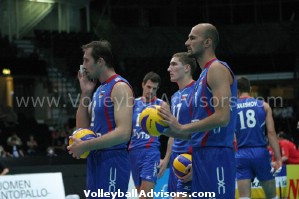 that the drills mimic the real game as much as possible.
that the drills mimic the real game as much as possible. Mimicking the game means drills should take place in the game context, i.e. the volleyball should be flying over the net, opponents should be placed in the other side of the net, etc.
Take a look at the next example.
Example: How to make a hitting drills a gamelike volleyball drill?
For example in hitting drill it means the setter sets (not toss!) the ball for the hitter. Also the opponent's defense (blockers and defenders) should be in place to stop the spiker.To make it even more game-like, the server should serve the ball over the net for the passer who receives it to the setter.
This gamelike setup helps the hitter to work on timing and take into account the opponent's block.
Spiking without having the block and defense in place wouldn't be that much help.
II Keep Score. Add Pressure and Competition
One other way to make volleyball team drills more game-like is to add pressure on the players by keeping score or stats.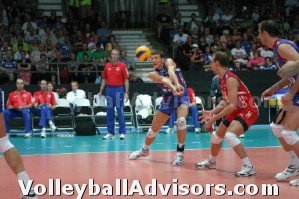
Try to keep the score whenever possible.
Measure the length of the drill by good repetitions.
Make players compete also in practice.
The coach could run a competition in the hitting drill; i.e. between a starter and the player who wants the starting spot.
The coach could be keeping stats to determine who is the best passer in the team. The coach could take it so far that s/he promises the best passer a starting position in the next match.
Volleyball Team Drills – Serve and Serve Receive Drill
Example 1 - Serve Receive Volleyball Drill
Wash drill is traditionally used in offense vs. defense setting, in which two opposing teams are competing against each other for points.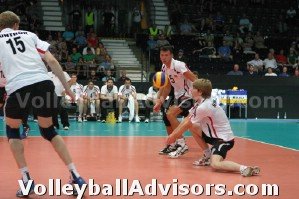
A wash drill can be used in servers vs. serve receive set up as well.
Team vs. Team
Set up three passers to pass the ball. The passers are competiting as a team against the 5-6 servers.
Having at least 5-6 servers makes it possible to use fast tempo in the drill, which maximizes the contacts in the short period of time. (Take into account that each player needs time to focus and concentrate on each serve - just like in the match.)
In the match, players need to be able to serve the ball to specific locations on the court.
In the drills below, servers are required to target their serves to specific areas.
Example 2 - Serve Receive Volleyball Drill
Few Servers vs. Invididual Player - Serving LinesTarget: Zone 1 Sideline
The server needs to aim the serve to the sideline, i.e. between the line and the passer in zone 1. The more specific the better.
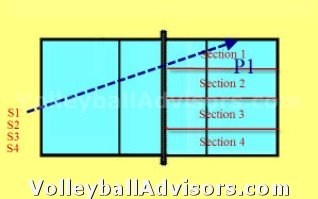 Mark the area on the court with
pieces of tape or dots. Use i.e. 7½ foot (2,3 meter) wide area
as the target area. Look at the picture on the right.
Mark the area on the court with
pieces of tape or dots. Use i.e. 7½ foot (2,3 meter) wide area
as the target area. Look at the picture on the right.
If you have very skilled players you could make the area even narrower.
However, make sure the serve receiver stands in the natural serve receive position - just like in the match.
Few Servers vs. One Passer
In this drill, one passer is competing against few servers.
Variation 2:
Make other few servers to serve to another serve receiver to another sideline, between the line and the passer in zone 5.
Example 3 - Serve Receive Volleyball Drill
3-4 Servers vs. Two PassersWhy two passers? In the match servers target their serves often between two serve receivers.
Target: Between the Two Passers
I.e. the server has to target the serve between zone 1 and zone 6, in the area between two passers on the right in the three person serve receive line up.
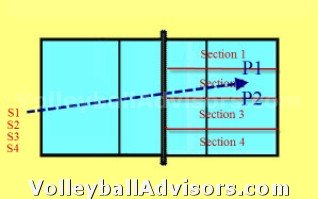
3-4 Servers vs. Passers
Use at least 3-4 servers in serving to keep up fast tempo in serving.
Mark around 7½ foot (2,3 meter) or even smaller area between the two passers for the servers to land their serves in.
Variation 2:
Naturally you should practice also serving between Zone 5 and Zone 6 passers - the area between two passers on the left - in the three person line up.
Example 4 - Serve Receive Volleyball Drill
One Server vs. Individual PlayerYou could also set up one vs. one drill.
I.e. make non-starting outside hitter competing against the starting outside hitter. This kind of set up is extremely competitive.
Target: Lines or Other Area
Use specific area of the court as the target. You can use i.e. 7½ foot (2,3 meter) wide area just like above.
Keeping Score and Adding Competition in Volleyball Team Drills
In order to teach the serves take risks and add power on their serve,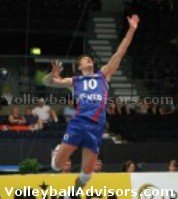 some extra allowances should be made.
some extra allowances should be made.They can miss some serves in the drill as they experiment. For example, servers can be allowed to miss one serve but not two serves in a row.
One other allowance could be that they are allowed to miss the serve wide when targeting the sideline, but all other errors (net or long) should be penalized. The serves also could earn two or three points, if they serve an ace.
Why It Is Important to Let Volleyball Servers Take Risks?
Letting servers to take risks and miss serves in volleyball team drills is important. When servers add power it will benefit the passers who get opportunity to pass difficult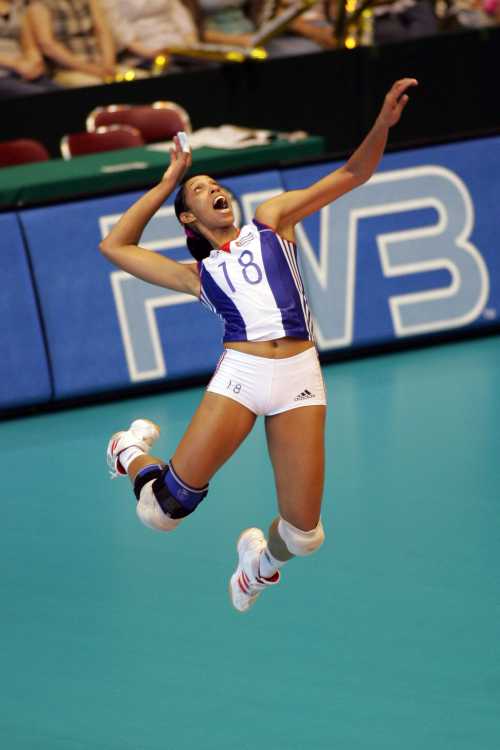 serves, more difficult ones than they usually get in the match.
serves, more difficult ones than they usually get in the match.It also gives servers the opportunity to try new, more daring serves, which can’t be practiced in the match. The only way servers learn to serve hard is to let them hit the volleyball hard when serving, which often means missed serves in the beginning.
To keep the drill moving and maximize the repetition it is important to serve with the fast tempo, so there needs to be several servers waiting their turn on the line. It is important servers do the same routines as in the game. In order to keep up the fast tempo servers need to start their routines before the previous server has finished.
Serve Receivers
In the match, servers need to target their serves to the specific spots on the court. In this drill passers get to practice serves, which are aimed to specific spots.
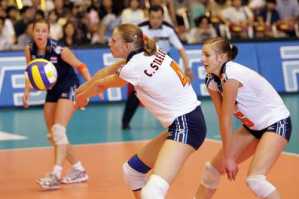
To prepare serve receivers to pass difficult jump serves and float serves in the game, it is important to expose servers overly difficult serves in the practice.
Servers need to put extra power and accuracy on their serves. In order to do it servers should be allowed to make some extra errors.
Serving in Volleyball Team Drills
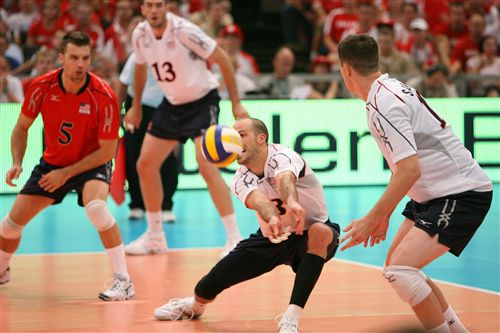 The serving-passing drill
should go through all various serving spots.
The serving-passing drill
should go through all various serving spots. There are at least four spots, where servers should aim their serves: the spots between the passers (2 of them) and both side lines (2). Servers also need to have short serves in their serving repertoire.
In the passing drill passers need to be exposed to various serves; float serves, jump floaters and jump serves, etc.
Volleyball Team Drills - Making Drills More Gamelike
Adding Hitters and the Defense
The coach may want go a step further toward the game and add blocker and defensive players, so the setter and hitter can work on the offense.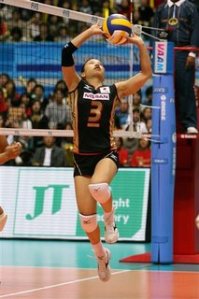
Setters in Volleyball Team Drills
Serve receivers aim to pass a perfect ball to the setter, therefore this gives the setter a good chance to work on the sets. The setter could set the ball for the decoy offensive player on the stand. To make it more game-like a hitter could be approaching the set. It gives the setter and hitter an opportunity to work on timing between them.
Hitters in Volleyball Team Drills
It is extremely important that hitters are hitting balls which are passed to the setter, so they get to practice timing. Moreover, if the coach wants also hitters to do a more gamelike drill then blockers and defensive players should be placed in the opposite side.
Passing Formations in Volleyball Team Drills
Several passing formations could be used. You don't necessarily need three passers to receive the ball - and still the drill can be like the game.
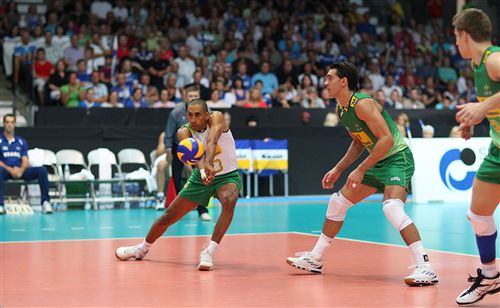
For example when aiming to serve between the players: two passers could be placed on the half court area when the serve is aimed between the zones 1 and 6.
If servers practice serving line serves, only one serve receiver is needed.
Keeping Score
The coach adds competition into the drill by giving servers a point after each perfect pass.
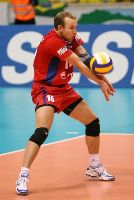 The coach needs to focus making the game as even as possible.
If one side is winning easily, the coach needs to adjust scoring to
make players compete. I.e. if passers dominate the competition, the
servers should be allowed to miss some serves without losing points.
The coach needs to focus making the game as even as possible.
If one side is winning easily, the coach needs to adjust scoring to
make players compete. I.e. if passers dominate the competition, the
servers should be allowed to miss some serves without losing points.How
to warm up for volleyball team drills?
Warm ups for volleyball team drills can be made more fun and useful for
the players. There are other options for warm ups than traditional
running-stretching combination.Who Cares About Warm Ups?
How often coaches and players pay attention to warm ups? Or does it really even matter what do you do for warm ups?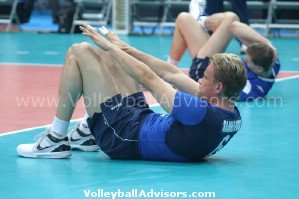
Why Volleyball Warm Ups Are Important?
For the club volleyball teams, or any team whose weekly practice time is limited, it is very important to pay attention to warm ups and not to waste any practice time.Teams often warm up by jogging around the court, running lines, doing some push ups, sit ups, stretching, etc. Those old fashioned warm up drills can take too much important practice time, especially if the practice time is very limited.
Generally junior club volleyball teams have 1 hour 30 minutes practices about 2-3 times a week. If warming up takes around 15-20 minutes, or even more out of the practice time, it probably would make sense to let players use the ball from the beginning - to warm up while doing simple drills with the ball.
How to avoid wasting practice time in volleyball team drills?
Especially for the junior volleyball players practicing technical skills is the most important matter. Also wouldn’t it be more fun if players would have a chance to work on some simple technical volleyball drills instead of running, conditioning and stretching?If you absolutely want to run traditional warm ups, try doing it before the practice, so you save practice time for volleyball.
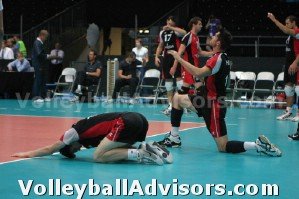
Why volleyball warm ups by running is not the best way?
Not only because of the time concerns, but another reason why you should consider moving away from traditional running is - it doesn’t really warm up you for volleyball. It doesn't warm up your arms and core, it affects mostly your legs.In case you are already doing volleyball footwork drills for warm ups, those can be easily included in some simple technical drills, instead of doing plain footwork without a ball.
Warm Up Drills for Volleyball Team Drills
The bottom line is; allow players practice technical skills during the warm up time. Start learning volleyball skills right away!Starting easy is very important to avoid injuries; the purpose is to warm up, not to use the full power in the beginning.
Example 1: Volleyball Warm Up Drills for Passers / Serve Receivers
- You could practice volleyball passing footwork
as a warm up for example by pairing players up. Players simply perform
passes
by feeding balls to each other.
It is more gamelike when the volleyball flies over the net.
So a better option is to form groups of three and practice passing when one person feeds the volleyball over the net. Feeders should remember to toss different tosses: long, short, left, right, etc. Passers need to work on various techniques, including a pass from the side by rotating the torso.
Or put two teams of two players in the opposite sides of the net. Volleyball is served over the net. After the serve receive, the receiving team serves the volleyball back over the net, etc. Serving team may switch positions after each serve. Use two balls on each side to make the drill more effective. You can easily set up at 4-5 teams next to each other, which means 15-20 players can do an effective warm up on the one court.
One more time; players are not warm yet therefore it is important to go very easy until they are warm.
Example 2: Volleyball Warm Up Drills for Setters
- If coach wants setters to practice
their footwork and setting skills, s/he can make setters to perform
their own warm ups
separately from the passers. One player feeds the ball to the
setting location and the setter sets the ball to a target who returns
the ball to the feeder.
If you have two setters as often in a volleyball team, one variation is the setters switch positions after each set - when the setter releases the ball to the target. Two setters (the feeder and setter) keep switching positions while the target remains as the target. This keeps two setters on the move all the time, but the tosser has to toss the ball pretty close to the 10 feet line.
It is important for the setters to perform setter's footwork when setting.
To make it easy first, don't let them set to long distance until they are warm - start for example with "2-ball".
Example 3: Volleyball Warm Up Drills for Middle Blockers
- Middle blockers could do blocking footwork at
the net for warm ups.
- Or if the practice theme is
blocking the whole team could be warming up by doing the blocking
footwork.
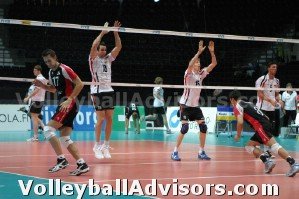
To make sure players start easy the coach could lower the net.
For beginning volleyball players lower net gives a good opportunity to work on timing and hand placement, if the coach wants to add a hitter to the other side of the net.
For the beginning volleyball players the hitters could be placed on the box - even though it is more beneficial to run blocking drills against a hitter who approaches and/or gets the set from the setter.
This is a warm up, so start slowly!
To check out how you can warm up by playing games, or warm up for the matches, go to our Volleyball Team Drills section about game warm ups.
Volleyball Quote to Remember

Volleyball Drills Related Pages
Volleyball Serving and Passing Drillsvolleytalk.com - Funny discussion about the worst volleyball drills
Like this page:





